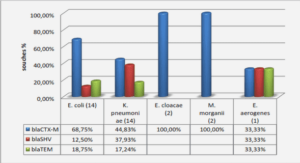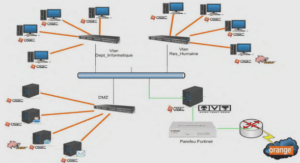LOCALIZATION IN WIRELESS NETWORK
Introduction to Wireless Network
Wireless deviees link physical world with the digital world via severa! techniques, and that is by gathering information and analyzing it about the studied object before converting this information to an easy form that can be proceeded. One of the famous approaches for localization in wireless network, is the wireless sensor network.
In the last few years, wireless sensor network had become one of the dominant technologies that can be used in different fields. WSN can be defined as a collection oflow cost and power sensors that can communicate wirelessly, each node in this network can since, process and has the ability to communicate with its peer .
WSN applications
One of the main advantages of sensors is there physical diversity, we have severa! types and forms of sensors, temperature, pressure, optical, acoustic, mechanical, vibration, position, chemical, humidity. Adding that, in the next few years the needs of wireless sensor network technology will increase more, and it is expected to form the core of the future intelligent network.
For this reason, wireless sensor network can be included in different sorts of applications..
Wireless sens or networks can be an essential part of military applications, the self-organization, fast deployment and low-cost characteristics of sensor networks make them very desirable for this application domain, like control, communications, computing, intelligence, surveillance, investigation and targeting systems. Since sensor networks are based on the dense deployment and low-cost sensor nodes, destruction of sorne nodes by aggressive attacks does not affect a military operation which makes wireless sensor networks a recovering approach for battlegrounds.
Many environmental applications of WSN include tracking the movements of birds, small animais, and insects; adding that, these applications may be implemented also in forest, exan1ple; fire detection, precision agriculture and flood detection, to monitor environmental conditions and ensure the security ofthe forests.
WSN can be the way of saving lives for many patients. Since now, WSN is implemented in many health caring applications, like tracking and monitoring doctors and patients inside a hospital, and that is by using special sensors that will be attached to the patient and each sensor has a specifie task.
Furthennore, WSN can be used in smart home applications like home automation where the deployed sensors allow end users to manage home deviees locally and remotely more easily.
Importance of Localization in wireless network
Sorne of WSN applications consist of distributing sensors in a random way, for example severa! applications consist of dropping thousands of sensors from an airplane in harsh environment (amazon forest), or in case of complex application, sensors may be distributed in mine environment, sorne ofthese distributed sens ors may be damaged, but a huge number of them will be able to work and communicate with the sink normally. Renee, knowing the sensors location is necessary to recuperate from them significant information. Consequent! y, localization has become an interesting topic for many researchers.
One of the famous approaches that has been most! y used in localization is the global positioning system (GPS), the main idea of GPS hinges on a method called triangulation or trilateration, it needs to get message from three satellites at !east to work properly; in order to
apply triangulation a GPS receiver measure the distance between itself and each satellite.
Despite ali the advantages that GPS offer, it’s still unsuitable in indoor areas and will not be a good choice due to different physical phenomena (attenuation, multipath … ) that can affect signal propagation.
Localization types
Since the GPS cannot offer a good solution for ali wireless applications, two common types of localization have been widely used; The range free techniques (hop count, APIT, centroid …. ), where the significant range information between the sensor nodes is not needed, and the rangebased techniques that use propagation signal information such as time of arrivai (TOA), time difference of arrivai (TDOA), angle of arrivai (AOA), and Received Signal Strength Indicator (RSSI). Range based techniques are characterized by being more accurate compared to range-free.
Most of localization techniques consist of using multiple anchors or reference nodes, nodes that we know the ir real position :
Range based localization
This type is characterized by being more accurate compared to range-free, where the information on distance/angle between sensor nodes are required, adding an extra hardware requirement.
Time based localization
Time of Arrivai (TOA): TOA ( also called time offlight method) based on the concept where the distance between two sensors can be calculated using the measured signal propagation time and the known signal velocity. Note that there is two types of TOA, one-way TOA and twoway TOA.
Based on One-way TOA
This method measures the one-way propagation time represented as the difference between the sending time and the signal arrivai time, One-way TOA requires highly accurate synchronization of the clocks for the sender and the receiver Nodej
Based on Two-way TOA
The two-way time of arrivai method is preferred, where the round-trip time of a signal 1s measured at the sender deviee as shown in figure 1-4.T2 T3 Where t 3 and t 4 represent the sending and receiving times of the response signal. Note that with one-way localization, the receiver node calculates its location, while in the two-way approach, the sender node calculates the receiver’s location. Therefore, a third message will be necessary in the two-way approach to inform the receiver of its location.
Two-way TOA is preferred, where the round-trip time of a signal is measured at the sender sensor.
|
Table des matières
General introduction
CHAPTER 1 LOCALIZATION IN WIRELESS NETWORK
1-1 Introduction to Wireless Network
1-2 WSN applications
1-3 Importance ofLocalization in wireless network
1-4 Localization types
1-5 Range based localization
1-5-1 Time based localization
1-5-2 Based on One-way TOA
1-5-3 Based on Two-way TOA
1-5-4 Based on Time Difference on Arrivai (TDoA)
1-5-5 Based on Angle of Arrivai (AoA)
1-5-6 Based on RSSI-Finger printing:
1-5-7 Trilateration
1-5-8 Based on Received Signal Strength (Path Joss mode!)
a) Reflection
b) Diffraction
c) Scattering
d) Doppler effect
e) Friis space equation
f) Path Joss equation
1-6 Range free
1-6-1 Approximate Point In Triangulation (APIT)
1-6-2 Distance Vector-hop (DV-HOP)
1-6-3 Centroid
1-6-4 Multi-Hop
1-7 Range free and range-based technique comparison
CHAPTER 2 GRADIENT DESCENT OPTIMIZATION APPROACH AND IMPACT OF INITIALIZATION
2-1 Optimization
2-2 Optimization technique in localization
2-2-1 Newton method
2-2-2 Gradient des cent method
2-3 Gradient Des cent in localization
2-4 Gradient des cent related work in localization
2-5 Block diagram of the algorithm
2-6 Distance estimation
2-7 Objective function and Coordinates estimation
2-8 Initialization techniques
a. Random initialization (RI)
b. Another random initialization (ARI)
c. Weighted initialization (WI)
2-9 Derivation
2-10 Simulation
2-10-1 Comparison between Gradient descent and trilateration
2-10-2 Localization using Gradient des cent technique and the effect of initialization
2-11 Coordinates error in each initialization
2-12 Time convergence of each initialization method
2-13 Result using multiple network scheme
Conclusion
CHAPTER 3 GRADIENT DESCENT PROPOSED APPROACH
3-1 Introduction
3-2 Proposed method for localization with known path loss condition
3-3 Proposed approach in unknown path loss conditions
CHAPTER 4 SIMULATION AND RE SUL TS
4-1 Simulation in known path loss condition
4-2 Simulation in unknown path loss condition
4-2-1 Network one
4-2-2 Network 2
4-2-3 Network 3
4-2-4 Network 4
CHAPTER 5 CONCLUSION
List of publication
RFERENCNES
APPENDIX
![]() Télécharger le rapport complet
Télécharger le rapport complet






